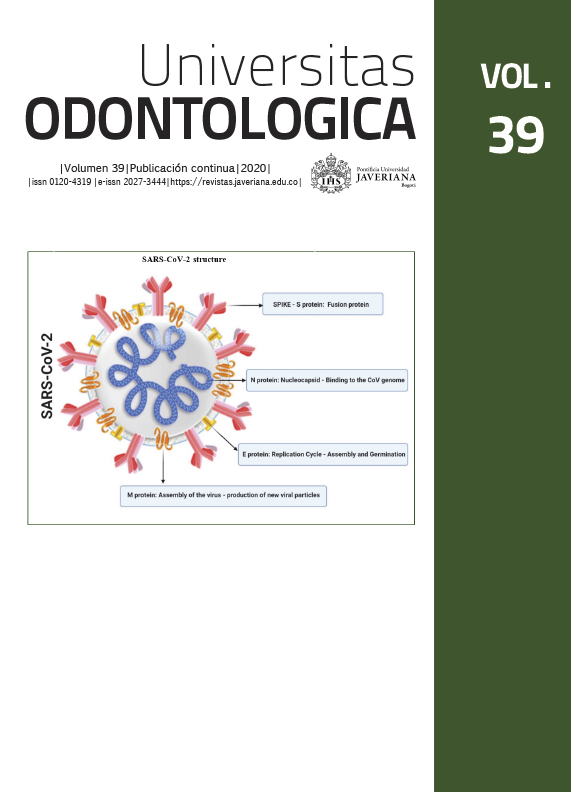Resumen
Antecedentes: el síndrome de Cri du Chat (SCdC) es un desorden genético de baja prevalencia. Es importante que odontólogo clínico conozca sus características craneofaciales y estomatológicas, al igual que las consideraciones para un buen manejo de estos pacientes en la consulta. Objetivo: identificar los avances recientes en el diagnóstico y manejo de pacientes con SCdC. Métodos: en esta revisión sistemática se efectuaron búsquedas en las bases de PubMed, SciELO, LiLACS y TripDatabase. Los términos de búsqueda fueron “Cri du Chat” y “síndrome del maullido del gato y odontología”, entre 2003 y 2018. Se obtuvieron y analizaron 25 artículos que cumplían con los criterios de inclusión y exclusión. Resultados: se confirmó la baja frecuencia de aparición del síndrome. Se identificaron características craneofaciales y orales representativas asociadas a micrognatismo y retrognatismo que alteran la apariencia facial del paciente. Alteraciones como el apiñamiento dental, la maloclusión y la enfermedad periodontal asociada se podrán corregir y controlar con higiene bucodental y guía nutricional adecuadas al paciente y sus padres. Conclusiones: el SCdC es poco frecuente. Sus características patognomónicas se presentan en la niñez y la adolescencia, por lo que requieren mayor atención. La detección temprana permite plantear un tratamiento adecuado para mejorar la calidad de vida de los pacientes.
Saldarriaga W, Collazoz-Saa L, Ramirez-Cheyne J. Cri-du-Chat syndrome diagnosed in a 21-year-old woman by means of comparative genomic hybridization. Rev Fac Med. 2017; 65(3): 525-529. http://doi.org/10.15446/revfacmed.v65n3.57414
Yáñez-Vico R, Rodríguez-Caballero Á, Iglesias-Linares A, Guerra-López N, Torres-Lagares D, Machuca-Portillo G. Craniofacial characteristics in cri-du-chat syndrome. Oral Med Oral Pathol Oral Radiol Endod. 2010; 110(6). http://doi.org/10.1016/j.tripleo.2010.08.021
Carbajo-Vélez M. Síndrome del maullido del gato. Intervención educativa. TABANQUE Rev Pedagog. 2012; 25: 235-250.
Rodríguez-Caballero A, Torres-Lagares D, Rodríguez-Pérez A, Serrera-Figallo MA, Hernández-Guisado JM, Machuca-Portillo G. Cri du chat syndrome: a critical review. Med Oral Patol Oral Cir Bucal. 2010 may; 15(3): 473-478. http://doi.org/10.4317/medoral.15.e473
Martín-Sanjuan C, Moreno-Martin C, de los Ríos JM, Urberuaga M, Domingo R. Consideraciones dentales en el síndrome de maullido de gato: a propósito de tres casos. Cient Dent. 2008 abr; 5(1): 45-48.
Corcuera-Flores JR, Casttellanos-Cosano L, Torres-Lagares D, Serrera-Figallo MÁ, Rodríguez-Caballero Á, Machuca-Portillo G. A systematic review of the oral and craniofacial manifestations of Cri du chat syndrome. Clin Anat. 2016; 29(5): 555-60. http://doi.org/10.1002/ca.22654
Martínez-Fernández M, Aceña M, McDonald A, Centeno-Malfaz F, Delicado A, Palomares M, Lapunzina P, Martínez Frías M. Paciente con síndrome de Cri-Du-Chat y de Beckwith-Wiedemann originados por un derivado de translocación paterna. Rev Dismorfol Epidemiol. 2009; 5(8).
Honjo R, Mello C, Pimenta E, Núñez E, Benedetto L, Khoury R, et al. Cri du Chat syndrome: Characteristics of 73 Brazilian patients. J Intellect Disab Res. 2018. http://doi.org/10.1111/jir.12476
Esparza-García E, Cárdenas-Conejo A, Huicochea-Montiel JC, Aráujo-Solís M. Cromosomas, cromosomopatías y su diagnóstico. Rev Mex Pediatr. 2017; 84(1): 30-39.
Cerruti-Maindari P. Cri du Chat syndrome. Orphanet J Rare Dis. 2006 Sep; 1(33): 1-9. https://doi.org/10.1186/1750-1172-1-33
Elmakky A, Carli D, Lugli L, et al. A three-generation family with terminal microdeletion involving 5p15.33-32 due to a whole-arm 5;15 chromosomal translocation with a steady phenotype of atypical cri du chat syndrome. Eur J Med Genet. 2014; 57(4): 145-150. https://doi.org/10.1016/j.ejmg.2014.02.005
Ochoa-Gómez L, Orden-Rueda C, Ruiz del Olmo JI, Clavero-Montañes N, Berdún-Cheliz E, Sánchez-Gimeno J. Síndrome Cri du Chat: a propósito de un caso. Características clínicas y evolutivas. Rev Español Pediatr. 2017; 73(2): 109-111.
Parra J, Peña M, Tamayo V, Fernández I, Peña L. Síndrome de maullido de gato o “Cri Du Chat”. Presentación de un caso. Rev Pediatr Electron. 2012; 9(1).
Santana Hernández E, Tamayo Chang V, Bruzón-Hernández M. Síndrome de 5p menos. Presentación de un caso. Medisur. 2014 oct; 12(4).
Kim KM, Kim JD. Effects of oral stimulation intervention in newborn babies with Cri du Chat syndrome: Single-Subject Research Design. Occupat Therapy Internat. 2018 May: 1-8. http://doi.or/10.1155/2018/6573508
Galo BL, Alvarenga R. Síndrome de Cri du Chat, una rara cromosopatía. Rev Med Hondur. 2012; 80(1).
Pereira J, Oliveira R, Lindemann D, de Araújo F, Almeida J. Cri-du-Chat syndrome: conservative dental treatment in an 8-year old child. Stomatos. 2013 jun; 19(36).
Rodríguez A, Torres D, Yáñez R, Gutiérrez J, Machuca G. Assessment of orofacial characteristics and oral pathology associated with cri-du-chat syndrome. Oral Dis. 2012; 18. https://doi.org/10.1111/j.1601-0825.2011.01864.x
Mainardi PC, Pastore G, Castronovo C, et al. The natural history of Cri du Chat Syndrome. A report from the Italian Register. Eur J Med Genet. 2006; 49(5): 363-383. https://doi.org/10.1016/j.ejmg.2005.12.004
Gómez E, Olivar A, García E, Domínguez M, Arias B. Manejo inicial del síndrome de Cri du Chat. Vox Pediatr. 2011; 18(1): 97-100.
Páez C, Borsatto M, Mussolino A, Campos F, Orsi I. Cri du Chat syndrome: A case report. Spec Care Dentist. 2005; 25(6).
Ballesta S, Machuca G, Torres D, Rodríguez A, Yañez R, Solano E, Perea E. Determination of periodontopathogens in patients with Cri du chat syndrome. Med Oral Patol Oral Cir Bucal. 2013 nov; 18(6): 883-887. https://doi.org/10.4317/medoral.19400
Liverani ME, Spano A, Danesino C, Malacarne M, Cavani S, Spunton M, Guala A. Children and adults affected by Cri du Chat syndrome. Care’s recommendation. Pediatr Report. 2019; 11: 7839.
Molina-García A, Castellanos-Cosano L, Machuca-Portillo G, Posada-de la Paz M. Impact of rare diseases in oral health. Med Oral Patol Oral Cir Bucal. 2016 sep; 21(5): 587-594.
Vega L, Díaz A, Arcas G, Satorre J, Satorre S, González E. Cardiopatías asociadas a síndromes genéticos diagnosticados en pacientes pediátricos. Acta Med Centro. 2017; 11(4).

Esta obra está bajo una licencia internacional Creative Commons Atribución 4.0.
Derechos de autor 2020 Aura Alejandra Viteri Rentería, Ana del Carmen Armas Vega, Álex Esteban Carrera Robalino, Adriana Patricia Paltas Miranda, Mayra Elizabeth Paltas Miranda



